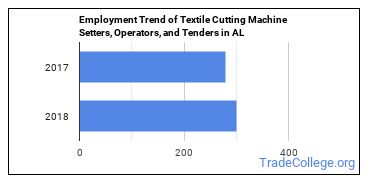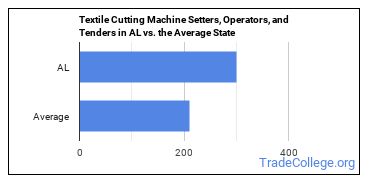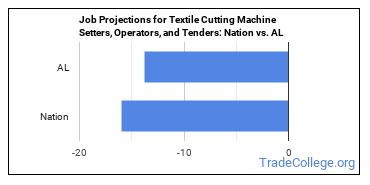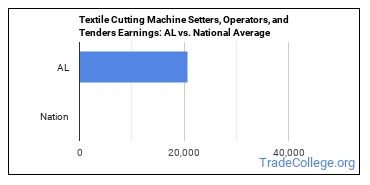Textile Cutting Machine Setters, Operators, and Tenders in Alabama
Get the information you need to know about working as a Textile Cutting Machine Setter, Operator, or Tender.
While jobs for Textile Cutting Machine Setters, Operators, and Tenders in Alabama are decreasing, those who do work in these jobs get paid higher than average.
-
Employment for Textile Cutting Machine Setters, Operators, and Tenders in Alabama is expected to decrease.
-
Textile Cutting Machine Setters, Operators, and Tenders in Alabama earn lower salaries than the typical U.S. wage earner.
Featured schools near , edit
How Many Textile Cutting Machine Setters, Operators, and Tenders Work in Alabama?
There were approximately 300 workers employed as Textile Cutting Machine Setters, Operators, and Tenders in this state in 2018.
There were 280 Textile Cutting Machine Setters, Operators, and Tenders employed in this state in 2017.
That’s growth of 20 jobs between 2017 and 2018.

The typical state has 210 Textile Cutting Machine Setters, Operators, and Tenders working in it, which means Alabama has more Textile Cutting Machine Setters, Operators, and Tenders than average.

Job Projections for Alabama
Jobs for Textile Cutting Machine Setters, Operators, and Tenders in this state are declining at a rate of 13.8% which is a slower decline than the nationwide estimated projection of

Alabama Annual Job Openings
The BLS is projecting 30 annual Textile Cutting Machine Setters, Operators, and Tenders job openings in Alabama, and 250 total jobs in the year 2026.
Nationwide, the prediction is 1,600 annual jobs and 12,600 total jobs in 2026.
What do Textile Cutting Machine Setters, Operators, and Tenders Make in Alabama?
In 2018 wages for Textile Cutting Machine Setters, Operators, and Tenders ranged from $16,500 to $30,940 with $20,760 being the median annual salary.
Broken down to an hourly rate, workers in this field made anywhere from $7.93 to $14.88. The median hourly rate was $9.98.
In 2017 the median pay for this field was $10.7 an hour.
The hourly rate declined by $0.72.
The median salary in Alabama is higher than the nationwide median salary.

Top Alabama Metros for Textile Cutting Machine Setters, Operators, and Tenders
The table below shows some of the metros in this state with the most Textile Cutting Machine Setters, Operators, and Tenders.
| Metro | Number Employed | Annual Median Salary |
|---|---|---|
| Dothan, AL | 40 | $24,230 |
Top States for Textile Cutting Machine Setters, Operators, and Tenders Employment
View the list below to see where most Textile Cutting Machine Setters, Operators, and Tenders work.
| State | Number Employed | Annual Median Salary |
|---|---|---|
| Georgia | 1,540 | $29,590 |
| California | 1,130 | $31,050 |
| North Carolina | 1,050 | $28,490 |
| Mississippi | 840 | $30,430 |
| Texas | 780 | $23,410 |
| South Carolina | 620 | $26,790 |
| Tennessee | 560 | $25,010 |
| New York | 510 | $35,430 |
| New Jersey | 400 | $29,120 |
| Arizona | 380 | $26,520 |
| Ohio | 380 | $30,050 |
| Florida | 360 | $27,030 |
| Michigan | 330 | $32,830 |
| Missouri | 320 | $23,930 |
| Alabama | 300 | $20,760 |
| Pennsylvania | 300 | $28,620 |
| Kentucky | 210 | $22,160 |
| Indiana | 190 | $28,170 |
| Maryland | 190 | $24,500 |
| Massachusetts | 180 | $28,750 |
Below are the states where Textile Cutting Machine Setters, Operators, and Tenders get paid the most:
| State | Annual Median Salary |
|---|---|
| New York | $35,430 |
| Maine | $35,240 |
| Washington | $34,780 |
| Michigan | $32,830 |
| Rhode Island | $32,390 |
| Iowa | $31,190 |
| California | $31,050 |
| New Hampshire | $30,670 |
| Illinois | $30,610 |
| Mississippi | $30,430 |
Related Careers in AL
Discover similar careers:
| Occupation | AL Employment Total |
|---|
References
- Bureau of Labor Statistics (BLS)
- College Factual
- National Center for Education Statistics
- O*NET Online
More about our data sources and methodologies.
Featured Schools
 Request Info
Request Info
|
Southern New Hampshire University You have goals. Southern New Hampshire University can help you get there. Whether you need a bachelor's degree to get into a career or want a master's degree to move up in your current career, SNHU has an online program for you. Find your degree from over 200 online programs. Learn More > |
